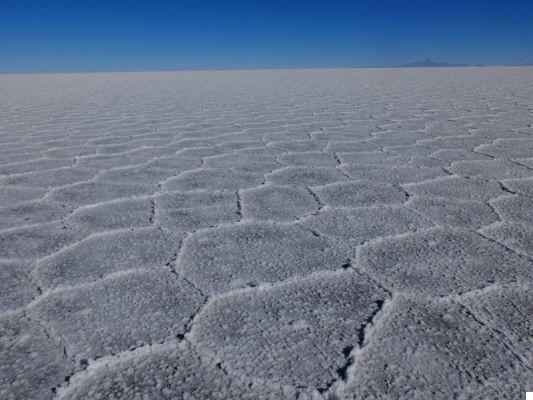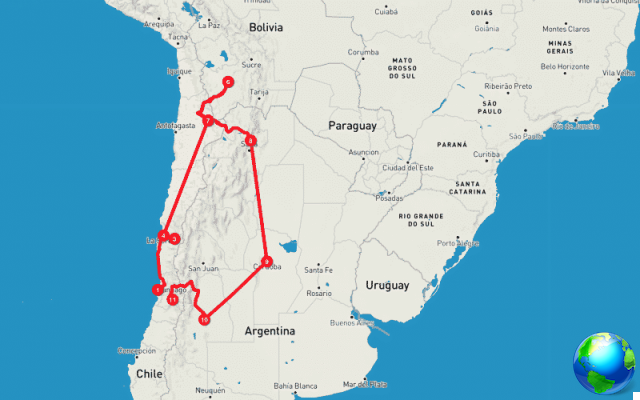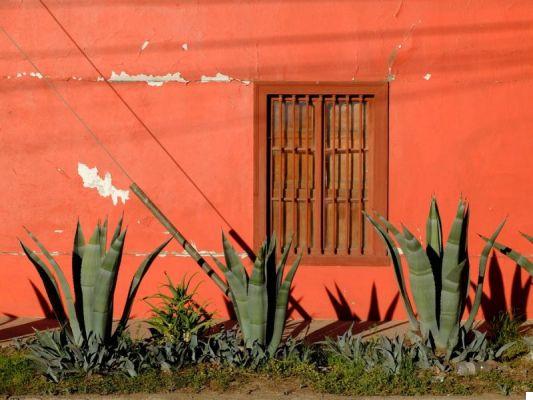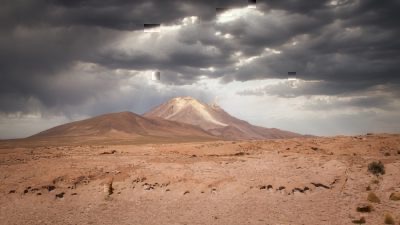
But let's start from the beginning ..
It all started with the desire to visit the Atacama desert in the far north of Chile. I love deserts in a particular way and seeing the highest desert in the world, as well as one of the driest areas on the planet, was on my wishlist for quite some time. This piece of the world is also famous for astronomical observatories, another great passion of mine, and you will understand that the choice came by itself.
Once the destination was defined, I started looking for a flight at an acceptable price (flights to South America are always quite expensive compared to flights to Asia or Africa)
In August in Chile it's winter, it's low season, so I decided not to book anything from Spain (except for the first two nights in Santiago, just so as not to waste time). In hindsight it was the right choice because I was able to define the itinerary gradually and I had no difficulty in finding a place on the buses and a bed to sleep.
If you decide to go there during our winter, however, some places (such as San Pedro de Atacama for example) are besieged by Chilean and South American tourists in general and you may encounter difficulties if you have not booked hostels and transfers in advance.
The trip eventually planned 11 days in Chile, 4 in Bolivia and 9 in Argentina

The detailed itinerary: Chile and Northern Argentina
- Santiago
- Santiago
- Valparaiso
- transfer by bus to La Serena along the Panamericana - Very nice road (7h - 20 euros)
- La Serena and transfer to Vicuna (1h and a half)
- Pisco Elqui (1h - 2,5 euro)
- sposting to San Pedro de Atacama (18h – 30 euro)
- San Pedro de Atacama (Hidden Lagoons of Baltinache and Valle della Luna)
- San Pedro de Atacama (Salar de Tara or Geiser del Tatio)
- Tour in Bolivia (Salar de Uyuni) 165 euros for 3 days
- Tour in Bolivia (Salar de Uyuni)
- Tour in Bolivia (Salar de Uyuni)
- Tour in Bolivia (Salar de Uyuni)
- San Pedro de Atacama
- San Pedro de Atacama
- Transfer by bus to Salta in Argentina (9-10h - 30 euros). Wonderful road (you cross the Andes)
- Salta
- Salta - gita to Cafayate (30 euro)
- Salta - trip to Cachi (30 euros)
- Skip - night transfer to Cordoba (12h - 73 euros)
- Cordoba and Alta Gracia
- Cordoba - night transfer to Mendoza (10h - 58 euros)
- Mendoza
- Transfer to Santiago (9h - 16 euros). Wonderful road (you cross the Andes)
- return flight
Direction Iguazu Falls
With more days to spare, it is definitely worth going to the magnificent ones from Cordoba Iguazu Falls, one of the 7 wonders of the world, shared by Brazil, Argentina and, to a lesser extent, Paraguay. Find all the info on this wonder of nature in the article of my colleague and friend Rocco D'Alessandro di Vitamina Project in his article Journey to ARGENTINA: how to visit the Iguazu Falls.
When to go to northern Chile, Argentina and Bolivia
As I mentioned, in August it goes towards the end of winter both in Chile / Bolivia and in Argentina. Temperatures are starting to rise, but you have to cover yourself. TO Santiago and Valparaiso the maximum was between 15 and 20 degrees (the minimums around 6-8), while in La Serena / Pisco and San Pedro the maximum could reach 25 degrees (and in the sun, with the altitude, they received at least 30). Both San Pedro and Salta used to wear t-shirts during the day but, being deserted, the temperature range is very strong and at night the temperature dropped to 0 degrees or even lower. This phenomenon is even more pronounced in Bolivia: with the altitude the sun is really strong during the day, but at night it is very cold (it touched -15 at dawn on the salar de Uyuni!). As my grandmother always used to say… you have to dress like an onion (possibly with technical and light clothing)! Temperatures aside, I always had a blue sky above my head, very few clouds and zero rain. He did 2 drops of number one day in Salta and it was a bit overcast in Santiago, otherwise always incredible days with almost blinding blue skies.
I retraced this same journey one more time in the month of November (2019), then at the beginning of the austral summer, and the temperatures were very different. TO Santiago and Valparaiso the temperatures reached 35 degrees during the day and a pleasant 20 degrees in the evening, ditto San Pedro, very hot in the day and cool in the evening. In Bolivia in the early morning and in the evening the temperatures were always quite cold (even 0 °), but during the day it was fine in a t-shirt, the same on the Salar de Uyuni. The coldest moments were the sunrise at the geiser del Tatio (-6 °), the sunrise on the Salar (about 0 °) and the border crossing between Chile and Bolivia which is located at 5000 meters.
As regards the Uyuni salt flat, it is almost always dry except in February when it usually rains and you can see the famous mirror effect (but you cannot reach the Inchauasi island).
How much does a trip to South America cost
Given that South America is not exactly the cheapest continent to travel, I spent a little less than I had imagined: I did not calculate to the penny but the trip (all inclusive) cost around 3000 euros for 25 days (2016).
Argentina was by far the most expensive country in 2016 of the 3 especially as regards the means of transport. At the same distance, a route that cost 30 euros in Chile in Argentina cost at least twice as much. To sleep, on the other hand, the prices were similar: on average I spent between 15 and 20 euros per person (double room with or without bathroom) or between 10 and 15 sleeping in the dormitory (with breakfast included).
In 2019, the Argentine pesos devalued by about 6 times and Argentina during this last trip turned out to be the cheapest state compared to Chile and Bolivia. Unfortunately in these countries the currency has frightening fluctuations so the cost of the trip can change dramatically between one period and another.
To eat, the price varies a lot: from a few euros to eat street food (empanadas, etc.) to 20-40 euros per person to eat fish or meat and drink excellent Carmenere or Malbec in a nice restaurant. The choice is very wide everywhere.
Also the price of the trips it is quite variable, ranging from 30 euros for half-day trips, to 50/80 euros for full-day trips (which often include lunch).
While I prepare the detailed articles that will follow on Chile, Bolivia and Argentina, I anticipate that, of the whole trip, I left my heart in Chile. Don't get me wrong, I have seen incredible places also in Argentina and especially in Bolivia, but from every trip we go back with a place of the heart, a special place that remains impressed more than the others. Here, for me it was the Atacama desert.
Health insurance is required
In Chile, Bolivia and Argentina our health coverage is not valid. My advice is to always take a classic medical-luggage insurance that can cover you during the trip. I am very happy with many insurance companies, a site that compares the policies of different companies and proposes the most convenient policy for that particular trip. To do this you will have to enter the data relating to your trip (country, duration, etc.) and they will send you an email with the best proposal that you can then buy directly online.
How to get around Chile and Argentina
All of South America has a really well developed bus network and, in my opinion, the bus remains the best way to get around and to visit like-a-local countries. There are buses of all classes, from basic, super cheap, to VIP. I tend to always use the medium-high range tourist buses, and I book i "semi-room" seats (with 45 ° reclining seat) oi "bed" (with 90 ° reclining seat, perfect for night journeys). In all tourist buses there is always a bathroom (even the bus makes several stops for the bathroom) and they always provide a snack and a drink; in “cama” trips a hot meal and various snacks + drinks are often included. Tickets can be purchased at bus stations; Unfortunately you can't buy them online because the sites require a document from Chile, Argentina, etc. depending on the company. There are many bus companies, but just enter the route you are interested in on Google and you will easily find the website of the company you are interested in with all the timetables. Another site that I find very useful, especially in the planning phase, is the site of Rome2Rio, where there are all the options to get to a certain place.
In Chile there are also low-cost airlines (Sky, Jet Smart for example) covering the whole country. If you have little time available, consider taking some flights by plane.
Find all the more specific information in these in-depth articles:
What to see in Santiago de Chile
Travel to northern Chile: from Santiago to San Pedro de Atacama
San Pedro de Atacama (Chile): what to see
In Bolivia: my 4 days tour to Salar de Uyuni
Northern Argentina: Salta, Cordoba and Mendoza





